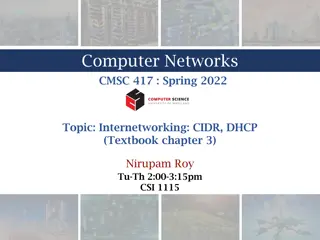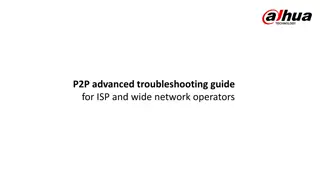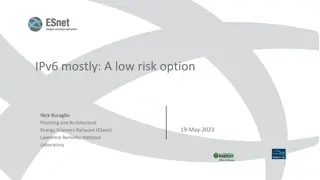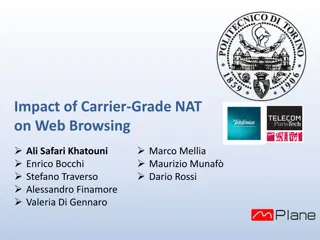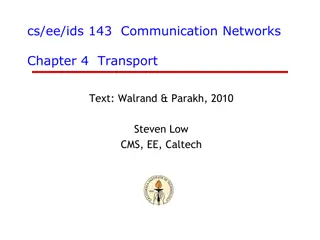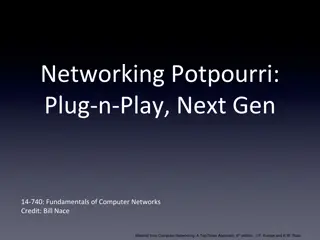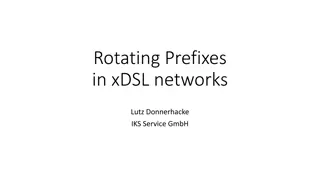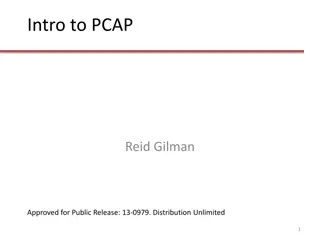
DHCP and NAT Protocols for Efficient Network Configuration
Explore the concepts of DHCP (Dynamic Host Configuration Protocol) and NAT (Network Address Translation) to automate IP address allocation, streamline network setups, and enhance network management efficiency. Learn about DHCP's dynamic address assignment, address allocation mechanisms, and the benefits of dynamic allocation. Discover how DHCP resolves manual configuration challenges, supports customized configurations, and provides a scalable solution for network administration.
Uploaded on | 1 Views
Download Presentation

Please find below an Image/Link to download the presentation.
The content on the website is provided AS IS for your information and personal use only. It may not be sold, licensed, or shared on other websites without obtaining consent from the author. If you encounter any issues during the download, it is possible that the publisher has removed the file from their server.
You are allowed to download the files provided on this website for personal or commercial use, subject to the condition that they are used lawfully. All files are the property of their respective owners.
The content on the website is provided AS IS for your information and personal use only. It may not be sold, licensed, or shared on other websites without obtaining consent from the author.
E N D
Presentation Transcript
DHCP Dynamic Host Configuration Protocol
Computer Center, CS, NCTU DHCP Motivation BOOTP Support sending extra information beyond an IP address to a client to enable customized configuration Effectively solve one of the major problems that administrators have with manual configuration Problems of BOOTP BOOTP normally uses a static method of determining what IP address to assign to a device Dynamic Host Configuration Protocol (DHCP) DHCP is an extension of the BOOTP. The first word describe the most important new capability added to BOOTP Assign IP dynamically Move away from static, permanent IP address assignment Compatible with BOOTP 3
Computer Center, CS, NCTU DHCP introduction DHCP Dynamic address assignment A pool of IP address is used to dynamically allocate addresses Still support static mapping of addresses Enable a DHCP client to lease a variety of network parameters IP, netmask Default router, DNS servers A system can connect to a network and obtain the necessary information dynamically Client-Server architecture DHCP client broadcasts request for configuration info. UDP port 68 DHCP server reply on UDP port 67, including IP, netmask, DNS, router, IP lease time, etc. RFC RFC 2131 Dynamic Host Configuration Protocol RFC 2132 DHCP Options Two main function of DHCP Provide a mechanism for assigning addresses A method by which clients can request addresses and other configurations 4
Computer Center, CS, NCTU DHCP Address Assignment Address allocation mechanisms Provide flexibility for configuring addresses on different types of clients Three different address allocation mechanisms Manual allocation IP address is pre-allocated to a single device Automatic allocation Assign an IP address permanently to a device Dynamic allocation Assign an IP address from a pool for a limited period of time Manual allocation Equivalent to the method BOOTP used For servers and routers Administrative benefit 5
Computer Center, CS, NCTU Dynamic allocation Benefits for dynamic allocation Automation No intervention for an administrator Centralized management An administrator can easily look to see which devices are using which addresses Address reuse and sharing Portability and universality Do NOT require DHCP server know the identify of each client Support mobile devices Conflict avoidance 6
Computer Center, CS, NCTU DHCP Leases Dynamic address allocation is by far the most popular Hosts are said to lease an address instead of own one DHCP lease length policy A trade-off between stability and allocation efficiency The primary benefit of using long lease is that the addresses of hosts are relatively stable Servers The main drawback of using long leases is to increase the amount of time that an IP can be reused Assigning lease length by client type Use long lease for desktop computers Use short lease for mobile devices Factoring lease renewal into lease length selection 7
Computer Center, CS, NCTU DHCP Lease Life Cycle Life cycle Allocation Reallocation Normal operation Renewal Rebinding Release 8
Computer Center, CS, NCTU DHCP Lease Address Pools Each DHCP server maintains a set of IP addresses Use to allocate leases to clients Most of clients are equals A range of addresses is normally handled as a single group defined for a particular network 9
Computer Center, CS, NCTU DHCP Protocol (1) client server DHCP Discover Broadcasted by client to find available server Client can request its last-known IP, but the server can ignore it DHCP Offer Server find IP for client based on clients hardware address (MAC) DHCP Request Client request the IP it want to the server. DHCP Acknowledge Server acknowledges the client, admit him to use the requested IP DHCP Discover src: 0.0.0.0 port: 68 dst: 255.255.255.255 port: 67 IP=192.168.1.100 netmask=255.255.255.0 router=192.168.1.1 dns=192.168.1.1 IP lease time=1 day DHCP Offer src: 192.168.1.1 port: 67 dst: 255.255.255.255 port: 68 DHCP option DHCP Request src: 0.0.0.0 port: 68 dst: 255.255.255.255 port: 67 DHCP option Request IP=192.168.1.100 DHCP Server=192.168.1.1 IP=192.168.1.100 netmask=255.255.255.0 router=192.168.1.1 dns=192.168.1.1 IP lease time=1 day DHCP Ack Question src: 192.168.1.1 port: 67 dst: 255.255.255.255 port: 68 Why not use the IP after DHCP offer? DHCP option 10
Computer Center, CS, NCTU DHCP Protocol (2) DHCP Inform Request more information than the server sent Repeat data for a particular application ex. browsers request web proxy settings from server It does not refresh the IP expiry time in server s database DHCP Release Client send this request to server to releases the IP, and the client will un-configure this IP Not mandatory 11
Computer Center, CS, NCTU DHCP server on FreeBSD (1) Kernel support device bpf pseudo-device bpf Install DHCP server /usr/ports/net/isc-dhcp44-server/ pkg install isc-dhcp44-server Enable DHCP server in /etc/rc.conf dhcpd_enable="YES" dhcpd_flags="-q" dhcpd_conf="/usr/local/etc/dhcpd.conf" dhcpd_ifaces="" dhcpd_withumask="022" (FreeBSD 5.x ) (FreeBSD 4.x ) 12
Computer Center, CS, NCTU DHCP server on FreeBSD (2) Option definitions option domain-name "cs.nctu.edu.tw"; option domain-name-servers 140.113.235.107, 140.113.1.1; default-lease-time 600; max-lease-time 7200; ddns-update-style none; log-facility local7; /etc/syslogd.conf /etc/newsyslog.conf 13
Computer Center, CS, NCTU DHCP server on FreeBSD (3) Subnet definition subnet 192.168.1.0 netmask 255.255.255.0 { range 192.168.1.101 192.168.1.200; option domain-name "cs.nctu.edu.tw"; option routers 192.168.1.254; option broadcast-address 192.168.1.255; option domain-name-servers 140.113.17.5, 140.113.1.1; default-lease-time 3600; max-lease-time 21600; } Host definition host fantasia { hardware ethernet 08:00:07:26:c0:a5; fixed-address 192.168.1.30; } host denyClient { hardware ethernet 00:07:95:fd:12:13; deny booting; } 14
Computer Center, CS, NCTU DHCP server on FreeBSD (4) Important files /usr/local/sbin/dhcpd /usr/local/etc/dhcpd.conf /var/db/dhcpd.leases /usr/local/etc/rc.d/isc-dhcpd (leases issued) 15
NAT Network Address Translation
Computer Center, CS, NCTU IP address crisis IP address crisis Run out of class B address The most desirable ones for moderately large organizations IP address were being allocated on a FCFS With no locality of reference Solutions Short term Subnetting and CIDR (classless inter-domain routing) NAT (network address translation) Long term IPv6 17
Computer Center, CS, NCTU Network Address Translation (NAT) Some important characteristics of how most organizations use the internet Most hosts are client Few hosts access the internet simultaneously Internet communications are routed Network Address Translation RFC 1631, in May 1994 A basic implementation of NAT involves Using one of the private addresses for local networks Assigned one or more public IP addresses The word translator refers to the device that implements NAT 18
Computer Center, CS, NCTU Private Address Space Private addresses space defined by RFC1918 24-bit block (Class A) 10.0.0.0/8 20-bit block (16 contiguous Class B) 172.16.0.0/12 ~ 172.31.0.0/12 16-bit block (256 contiguous Class C) 192.168.0.0/16 ~ 192.168.255.0/16 Operation consideration Router should set up filters for both inbound and outbound private network traffic 19
Computer Center, CS, NCTU Network Address Translation (NAT) What is NAT? Network Address Translation Re-write the source and/or destination addresses of IP packets when they pass through a router or firewall What can be re-written? Source/destination IPs Source/destination ports What can NAT do? Solve the IPv4 address shortage. (the most common purpose) Kind of firewall (security) Load balancing Fail over (for service requiring high availability) 20
Computer Center, CS, NCTU NAT Terminology 21
Computer Center, CS, NCTU NAT Address Mappings Each time a NAT router encounters an IP datagram It must translate addresses BUT, how does it know what to translate, and what to use for the translated addresses Translation table Maps the inside local address to the inside global address Also contains mappings between outside global address and outside local address for inbound translations Two address mappings Static mappings Allow the inside host with an inside local address to always use a inside global address Dynamic mappings Allow a pool of inside global addresses to be shared by a large number of inside hosts 22
Computer Center, CS, NCTU NAT Unidirectional Operation NAT Unidirectional Operation Traditional/Outbound operation The original variety of NAT in RFC 1631 The simplest NAT The client/server request/response communication would sent from the inside to outside network 23
Computer Center, CS, NCTU NAT Bidirectional Operation NAT Bidirectional Operation Two-Way/Inbound operation A host on the outside network initiate a transaction with one on the inside The problem with inbound NAT NAT is inherently asymmetric The outside network does not know the private addresses of the inside network Hidden addresses are not routable The outbound hosts DO NOT know the identity of the NAT router NAT mapping table 24
Computer Center, CS, NCTU NAT Bidirectional Operation Two methods to resolve the hidden address problem Static mapping DNS RFC 2694, DNS extensions to NAT The basic process is as follows The outside host sends a DNS request using the name of the private host The DNS server for the internal network resolves the name into an inside local address The inside local address is passed to NAT and used to create a dynamic mapping DNS server sends back the name resolution with the inside global address 25
Computer Center, CS, NCTU NAT Bidirectional Operation 26
Computer Center, CS, NCTU NAT Port-Based Operation NAT Port-Based Operation Overloaded operation Network Address Port Translation (NAPT)/Port Address Translation (PAT) Both traditional NAT and bidirectional NAT work by swapping inside network and outside network addresses One-to-one mapping between inside local address and inside global address Use dynamic address assignment to allow a large number of private hosts to share a small number of registered public addresses Using ports to multiplex private addresses Also translate port addresses Allow 250 hosts on the private network to use only 20 IP address Overloading of an inside global address 27
Computer Center, CS, NCTU NAT Port-Based Operation 28
Computer Center, CS, NCTU NAT Port-Based Operation NAT example: 29
Computer Center, CS, NCTU NAT Overlapping Operation NAT Overlapping Operation Twice NAT Operation The previous three versions of NAT are normally used to connect a network using private, non-routable addresses to the public internet No overlap between the address spaces of the inside and outside network Cases with overlapping private and public address blocks Private network to private network connections Invalid assignment of public address space to private network Dealing with overlapping blocks by using NAT twice Translate both the source and destination address on each transition Rely on use of the DNS Let the inside network send requests to the overlapping network in a way that can be uniquely identified 30
Computer Center, CS, NCTU NAT Overlapping Operation A client, 18.0.0.18, wants to send a request to the server www.twicenat.mit.edu, 18.1.2.3. 18.0.0.18 sends a DNS request NAT router intercepts this DNS request Consult its tables to find a special mapping for this outside host NAT router returns 172.16.44.55 to the source client 31
Computer Center, CS, NCTU NAT Compatibility Issues It is NOT possible for NAT to be completely transparent to the hosts that use it ICMP Manipulations Applications that embed IP address FTP Additional issues with port translation The issues applying to addresses now apply to ports as well Problems with IPSec 32
Computer Center, CS, NCTU SNAT SNAT & DNAT S: Source D: Destination SNAT Rewrite the source IP and/or Port. The rewritten packet looks like one sent by the NAT server. S: 192.168.1.1:1234 D: 140.113.235.107:53 S: 140.113.235.250:10234 D: 140.113.235.107:53 192.168.1.254 140.113.235.250 192.168.1.1 140.113.235.250 NAT Mapping Table: 192.168.1.1:1234 140.113.235.250:10234 33
Computer Center, CS, NCTU DNAT DNAT Rewrite the destination IP and/or Port. The rewritten packet will be redirect to another IP address when it pass through NAT server. S: 140.113.24.107:1357 D: 192.168.1.1:80 S: 140.113.24.107:1357 D: 140.113.235.107:8080 192.168.1.254 140.113.235.250 192.168.1.1 140.113.24.107 NAT Mapping Table: 140.113.235.250:8080 192.168.1.1:80 Both SNAT and DNAT are usually used together in coordination for two-way communication. 34
Computer Center, CS, NCTU NAT on FreeBSD (1) Setup Network topology configuration Advanced redirection configuration 192.168.1.1 Web server 192.168.1.2 Ftp Server 192.168.1.101 PC1 35
Computer Center, CS, NCTU NAT on FreeBSD (2) IP configuration (in /etc/rc.conf) ifconfig_fxp0="inet 140.113.235.4 netmask 255.255.255.0 media autoselect" ifconfig_fxp1="inet 192.168.1.254 netmask 255.255.255.0 media autoselect defaultrouter="140.113.235.254 Enable NAT Here we use Packet Filter (PF) as our NAT server Configuration file: /etc/pf.conf nat rdr binat # macro definitions extdev='fxp0 intranet='192.168.1.0/24 webserver= 192.168.1.1 ftpserver= 192.168.1.2 pc1= 192.168.1.101 # nat rules nat on $extdev inet from $intranet to any -> $extdev rdr on $extdev inet proto tcp to port 80 -> $webserver port 80 rdr on $extdev inet proto tcp to port 443 -> $webserver port 443 rdr on $extdev inet proto tcp to port 21 -> $ftpserver port 21 36
Computer Center, CS, NCTU NAT on FreeBSD (3) # macro definitions extdev='fxp0 intranet='192.168.219.0/24 winxp= 192.168.219.1 server_int= 192.168.219.2 server_ext= 140.113.214.13 # nat rules nat on $extdev inet from $intranet to any -> $extdev rdr on $extdev inet proto tcp to port 3389 -> $winxp port 3389 binat on $extdev inet from $server_int to any -> $server_ext 37









